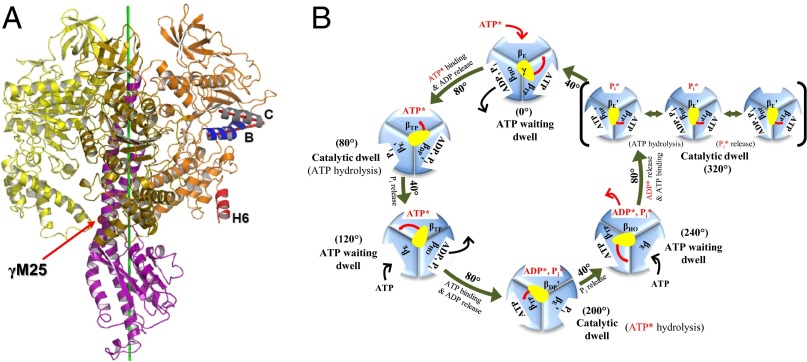Fig. 1.
(A) F1-ATPase. The three β-subunits and the γ-subunit are shown (α-subunits are not shown for clarity): βE (yellow), βDP (orange), βTP (gold), and γ (purple). To define the βDP subunit conformation we use the angle between helix B (βT163-A176) and helix C (βT190-G204). The two helices are highlighted: helix B (blue) and helix C (gray); the B^C angle is depicted as a red angle. The βDPH6 helix, whose orientation was reported to undergo a 20° change during the 40° substep γ-rotation, is highlighted as red. During the forced rotation simulations with an external torque, the force acts on the Cα atom of MF1:γM25 (shown as a red sphere). The direction of the force is determined as the cross-product of the radial vector of γM25:Cα and the rotational axis (green). (B) Proposed 360° rotation cycle of F1-ATPase showing the subunit conformations, as well as the binding–release of ligands and the hydrolysis of ATP. Starting from the binding of an ATP* to the βE subunit in the ATP waiting state (0°), rotation of the γ-stalk by 200° (80°, 40°, 80°) leads to the transition of βE (γ = 0°) via βTP (γ = 80°) to βDP (γ = 200°), the catalytic dwell state where hydrolysis of ATP* takes place. The hydrolysis product Pi* in the βDP subunit is not released at this catalytic dwell (200°). Instead, the other hydrolysis product ADP* is released first after a 40° rotation [βDP (200°) → βHO (240°)]. Then, βHO is transformed to βE and Pi* is released after an additional 80° rotation to another catalytic dwell state (320°); the latter is shown in brackets outside the main cycle (see below). Finally, the release of Pi* from βE leads to a 40° rotation that completes the 360° cycle (21, 41). The other subunits are going through corresponding cycles offset by 120° (βDP) and 240° (βTP), respectively. Here, the prime symbol when it appears on the βDP and βE conformations indicates that the conformation of corresponding subunits change slightly in or near the specified reaction steps. The γ-subunit is shown as a yellow oval, and its rotation during the hydrolysis cycle is indicated by a red arrow. The reaction steps occurring in or near the catalytic dwell and corresponding changes of ligands in each β-subunit are also shown in the 320° catalytic dwell: The first state (Left in the 320° catalytic dwell) has a bound ATP in βDP′, and is thus referred to as a prehydrolysis state (the state before the hydrolysis of ATP during the catalytic dwell). The second state (Middle) represents the state after ATP hydrolysis (posthydrolysis state), and the third state (Right) presents the state after the release of Pi bound in βE′ (postrelease state).

